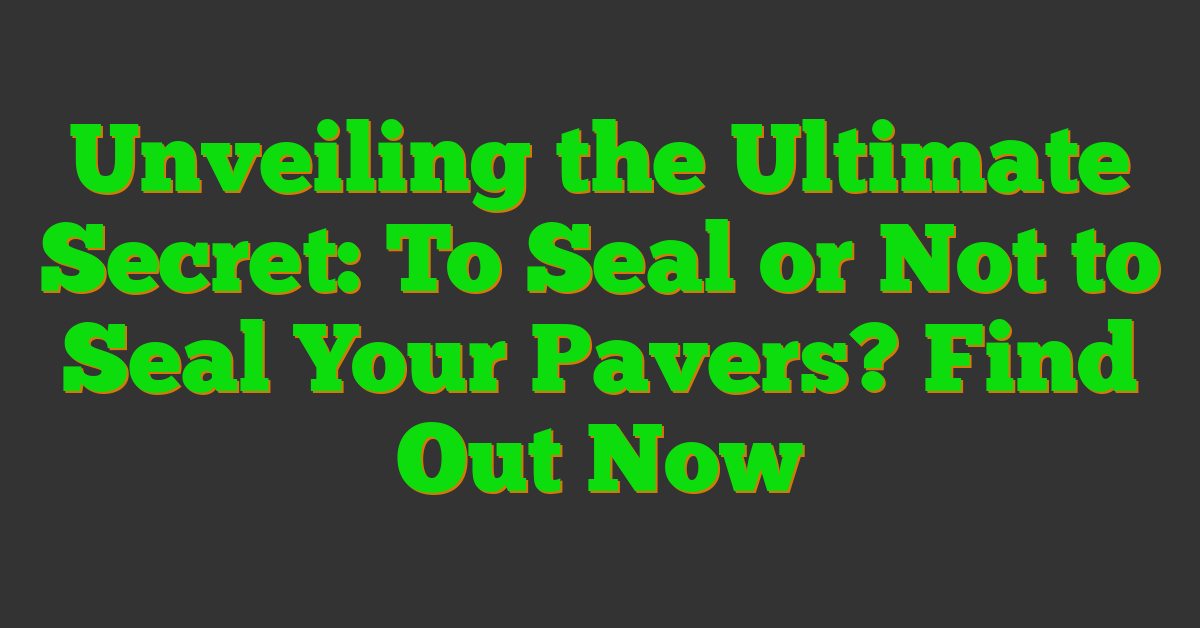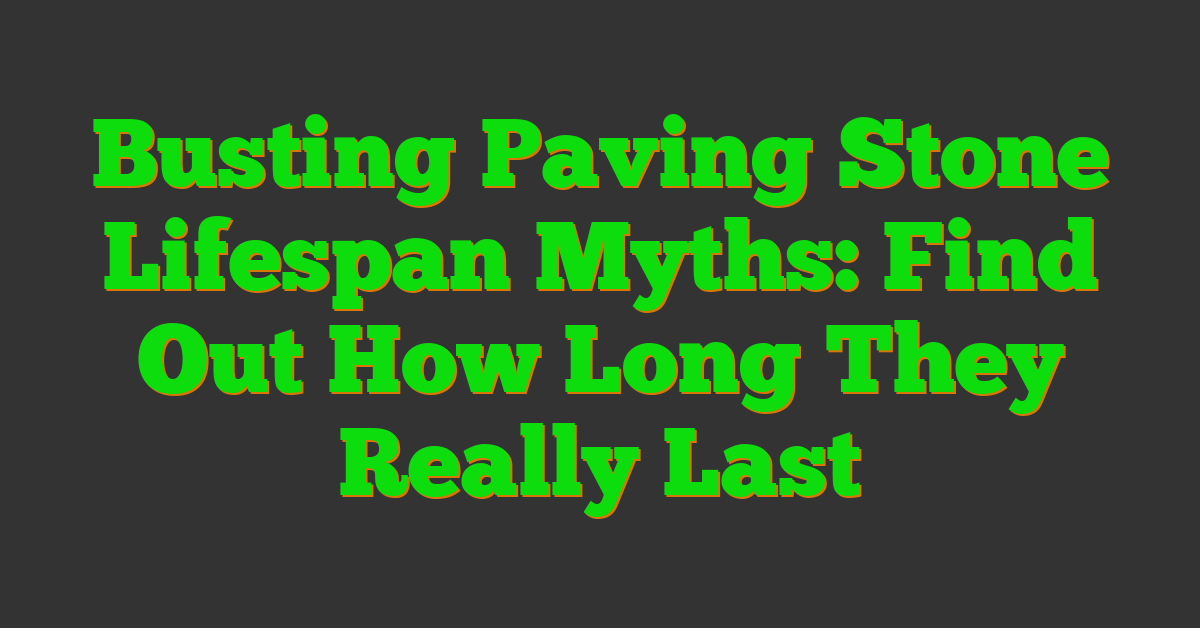So, you’ve just sealed your pavers, and now you’re probably wondering when it’s safe to take that first step. Walking on freshly sealed pavers too soon can ruin all your hard work, but waiting too long might not be necessary. We’re here to guide you on the right path for when you can confidently stroll on your newly sealed pavers.

Sealing your pavers is a great way to protect and enhance their appearance, but the curing process is crucial. It’s important to understand the optimal time to allow the sealant to set and bond effectively. By knowing when it’s safe to walk on sealed pavers, you can ensure a durable and long-lasting finish that will stand the test of time.
Let’s explore the timeline for when you can safely walk on your sealed pavers and enjoy your outdoor space without any worries.
Understanding Paver Sealing
The Purpose of Sealing Pavers
When it comes to landscaping projects, one crucial step that we always emphasize is sealing pavers. The primary purpose of sealing pavers is to protect them from various outdoor elements like dirt, stains, and water. By applying a sealant, we ensure that the pavers remain durable and maintain their appearance for an extended period.
Sealing pavers also enhances their color, providing a vibrant and fresh look to your outdoor space. It helps in locking in the jointing sand, preventing weeds from sprouting between the pavers and minimizing the growth of moss or mold. Additionally, sealing the pavers makes them easier to clean, saving you time and effort in maintenance.
Types of Sealants Used for Pavers
In our landscaping projects, we use different types of sealants suitable for various paver materials and finishes. The most common sealants for pavers are acrylic-based sealers, which offer excellent protection against UV rays and water damage. These sealers come in different finishes, including glossy and matte, allowing you to choose the look that best complements your outdoor design.
For natural stone pavers, we opt for penetrating sealers that provide a natural look while protecting the stones from within. These sealers are ideal for preserving the beauty of natural stone and ensuring longevity. We also consider solvent-based sealers for enhanced durability, especially in high-traffic areas where pavers are prone to wear and tear.
Understanding the different types of sealants available enables us to select the most suitable option for each project, ensuring that the sealed pavers not only look great but also withstand the test of time. By choosing the right sealant, we guarantee that your outdoor space remains pristine and inviting for years to come.
Preparing for Paver Sealing
Cleaning the Surface Before Sealing
Before we seal pavers, it’s crucial to ensure that the surface is clean and free from any debris. We recommend starting by thoroughly sweeping the pavers to remove dirt, leaves, and other materials. Next, washing the pavers with a mild detergent and water can help eliminate any stubborn stains or grime. Take the time to rinse the surface thoroughly and allow it to dry completely before proceeding with the sealing process. This preparation step will ensure a smooth and effective sealing application, enhancing the pavers’ durability and appearance.
Choosing the Right Weather Conditions
When it comes to sealing pavers, selecting the correct weather conditions is vital for a successful outcome. We suggest avoiding extreme temperatures, such as very hot or cold days, as they can affect the sealer’s application and drying process. Ideally, opt for a mild, dry day with moderate temperatures for sealing pavers. Additionally, it’s essential to check the forecast to ensure there is no rain expected for at least 24 hours after sealing. By considering the weather conditions, we can ensure that the sealing process is carried out under optimal circumstances, allowing the sealant to properly cure and protect the pavers.
The Sealing Process Explained
Applying the Sealant
When sealing pavers, we usually recommend applying the sealant once the pavers have been laid for at least 24 to 48 hours. This waiting period allows the pavers’ adhesive to set properly and ensures that the sealant can bond effectively with the surface.
We typically use a sprayer, roller, or brush to apply the sealant evenly across the pavers. It’s crucial to follow the manufacturer’s instructions regarding the number of coats needed and the drying times between each coat. By following these guidelines, we can achieve a uniform seal that enhances the overall appearance of the pavers.
Necessary Drying and Curing Times
After applying the sealant, it’s essential to allow sufficient drying and curing time before walking on the sealed pavers. Typically, the sealant needs around 24 to 48 hours to dry completely, but this can vary based on the specific product used and weather conditions.
To ensure proper curing, we advise avoiding any foot traffic or heavy objects on the sealed pavers during this period. This waiting time is crucial for allowing the sealant to penetrate and protect the pavers effectively. Once the sealant has fully dried and cured, you can confidently enjoy your newly sealed pavers with the assurance that they are well-protected and ready for use.
When Can You Walk on Sealed Pavers?
The Importance of Waiting
As landscape designers, we know the significance of patience when it comes to sealed pavers. It’s crucial to allow adequate time for the sealant to cure properly before introducing foot traffic. Walking on freshly sealed pavers prematurely can disrupt the curing process and compromise the overall finish.
Recommendations for Foot Traffic
Our recommendation for foot traffic on newly sealed pavers is to wait at least 24 to 48 hours after the final sealing application. During this time, it’s essential to avoid any pedestrian activity on the surface to ensure the sealant has fully set and bonded with the pavers. This waiting period guarantees that the sealant can provide optimal protection against outdoor elements, UV rays, weed growth, and other potential damages. By adhering to this waiting time, you can enjoy long-lasting results and maintain the aesthetic appeal of your paver installation.
Maintenance After Sealing
As landscape designers, we understand the importance of proper maintenance once your pavers have been sealed. This crucial step ensures that your outdoor space remains vibrant and well-protected for years to come.
Regular Cleaning Post-Sealing
After sealing your pavers, it’s essential to maintain a regular cleaning schedule to preserve the sealant and the overall appearance of your outdoor surface. We recommend using a mild detergent or specially formulated paver cleaner to remove dirt, stains, and other debris that may accumulate over time.
When cleaning sealed pavers, avoid harsh chemicals or abrasive cleaners that can damage the sealant. Instead, opt for gentle cleaning methods such as sweeping with a broom or rinsing with a garden hose. By keeping your sealed pavers clean, you not only enhance their longevity but also maintain their visual appeal.
« Unveiling the Ultimate Secret: To Seal or Not to Seal Concrete Pavers?
When to Reseal Your Pavers
Knowing when to reseal your pavers is crucial for maintaining their protective properties. As landscape designers, we advise homeowners to monitor the condition of their sealed pavers regularly. Look for signs of wear and tear, such as fading color or decreased water repellency.
In general, pavers should be resealed every 2-3 years to ensure optimal protection and longevity. However, factors such as foot traffic, weather exposure, and the type of sealant used can influence the resealing frequency. If you notice any deterioration in the sealant or paver appearance, it’s best to consult with a professional to determine the appropriate time for resealing.
By following these maintenance tips, you can ensure that your sealed pavers not only look stunning but also stand the test of time in your outdoor space.
Conclusion
Ensuring sealed pavers cure properly is key to their longevity and visual appeal. By following the recommended steps for sealing, maintenance, and post-sealing care, we can protect our outdoor spaces effectively. Remember to wait at least 24 to 48 hours after sealing before walking on the pavers to allow for proper curing. Regular cleaning and monitoring for wear are essential to keep the pavers looking their best. With the right maintenance routine, including resealing every few years, our sealed pavers will continue to enhance our outdoor areas for years to come. Stay proactive in caring for your pavers to enjoy their benefits for the long haul.












